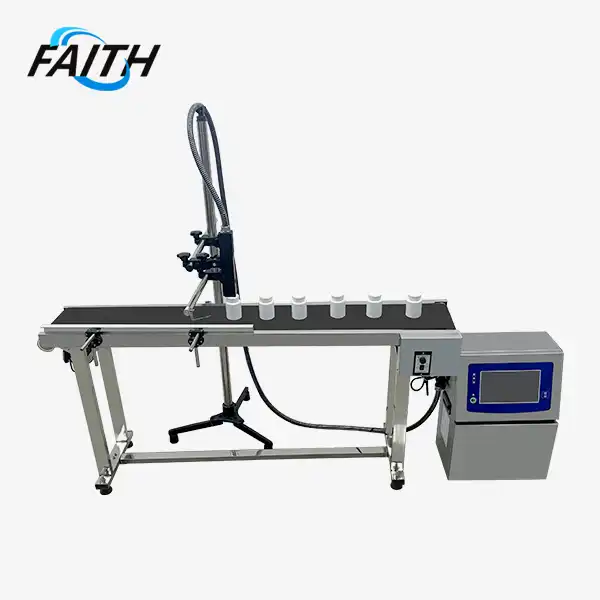How Mini Inkjet Printers Work in Retail Packaging?
Mini inkjet printers have revolutionized the retail packaging industry by offering a compact, versatile, and efficient solution for product labeling and coding. These portable devices utilize advanced inkjet technology to precisely deposit tiny droplets of ink onto various surfaces, creating high-quality text, barcodes, and graphics. In retail packaging, mini inkjet printers work by integrating seamlessly into production lines, allowing for real-time printing of essential information such as expiration dates, batch numbers, and product codes directly onto packaging materials. Their compact size, coupled with user-friendly interfaces and high-speed printing capabilities, makes them ideal for the fast-paced retail environment, ensuring accurate and legible markings on a wide range of packaging types.
The Technology Behind Mini Inkjet Printers in Retail Packaging
Inkjet Printing Mechanism
At the heart of mini inkjet printers lies a sophisticated printing mechanism that enables precise and rapid ink deposition. These printers utilize thermal or piezoelectric technology to eject microscopic ink droplets onto the target surface. In thermal inkjet printing, tiny heating elements vaporize the ink, creating bubbles that force droplets through nozzles. Piezoelectric systems, on the other hand, use crystals that change shape when electrically charged, pushing out ink droplets with remarkable accuracy.
The print head, a crucial component of mini inkjet printers, houses multiple nozzles arranged in a precise array. This configuration allows for high-resolution printing, typically ranging from 300 to 600 dpi (dots per inch), ensuring crisp and clear markings on retail packaging. The ability to control droplet size and placement with exceptional precision contributes to the versatility of these printers, enabling them to produce various font sizes, graphics, and even complex barcodes on diverse packaging materials.
Ink Formulations for Retail Packaging
Mini inkjet printers designed for retail packaging applications use specialized ink formulations tailored to meet the unique demands of the industry. These inks are engineered to adhere to a wide range of surfaces, including plastics, metals, cardboard, and even glass. Quick-drying properties are essential to prevent smudging and ensure that the printed information remains intact throughout the product's lifecycle.
Moreover, the inks used in these printers are often formulated to resist environmental factors such as moisture, UV light, and abrasion. This durability is crucial for retail packaging, as products may be exposed to various conditions during storage, transportation, and display. Some advanced ink formulations also offer features like invisible UV-readable ink for anti-counterfeiting measures or food-grade inks for direct printing on consumable product packaging.
Integrated Control Systems
Modern mini inkjet printers boast sophisticated integrated control systems that enhance their functionality and ease of use in retail packaging applications. These systems typically feature user-friendly interfaces, often in the form of color touchscreens, allowing operators to quickly input and edit printing data. The control systems manage various aspects of the printing process, including print head temperature, ink flow, and printing speed, ensuring consistent quality across production runs.
Many handheld inkjet printers also incorporate smart connectivity features, enabling integration with existing production line systems and databases. This connectivity allows for real-time updates of product information, batch numbers, and expiration dates, minimizing the risk of errors and improving traceability. Some advanced models even offer remote monitoring and control capabilities, allowing supervisors to manage multiple printers across different packaging lines from a centralized location.
Applications and Benefits of Mini Inkjet Printers in Retail Packaging
Versatility in Packaging Types
Mini inkjet printers excel in their ability to adapt to various packaging types commonly used in the retail sector. From cardboard boxes and plastic containers to foil pouches and glass bottles, these printers can effectively mark and code a diverse range of materials. This versatility is particularly valuable in retail environments where product lines may change frequently, requiring quick adjustments to packaging and labeling processes.
The compact design of mini inkjet printers, often featuring dimensions as small as 110x87x43mm and weighing just 240g, allows for easy integration into existing packaging lines. Their portability enables quick relocation between different production areas, providing flexibility in manufacturing setups. Additionally, some models come equipped with removable rollers, allowing for printing on curved surfaces – a significant advantage when dealing with cylindrical containers or irregularly shaped packaging.
Customization and Branding Opportunities
In the competitive retail landscape, product differentiation and branding are crucial. Mini inkjet printers offer extensive customization options, allowing retailers to enhance their packaging with unique identifiers, logos, and promotional messages. The ability to print high-resolution graphics and variable data in real-time opens up new possibilities for personalized packaging and limited-edition product runs.
The faith printers support a wide range of content types, including text, dates, graphic codes, variable graphic codes, counters, and even small tables. This versatility enables retailers to include essential product information, tracking codes, and marketing elements directly on the packaging. With support for multiple language input methods – often exceeding 20 different languages – mini inkjet printers cater to global markets, ensuring that product information is accessible to diverse consumer bases.
Cost-Effectiveness and Efficiency
The adoption of mini inkjet printers in retail packaging operations often leads to significant cost savings and efficiency improvements. These devices eliminate the need for pre-printed packaging or labels, reducing inventory costs and minimizing waste associated with outdated packaging materials. The ability to print on-demand allows for just-in-time production, helping retailers respond quickly to market demands and regulatory changes.
Furthermore, the high-speed performance of mini inkjet printers contributes to increased production line efficiency. With print speeds capable of keeping pace with fast-moving conveyor systems, these printers ensure that packaging processes are not bottlenecked by labeling requirements. The low maintenance needs and high ink utilization efficiency of modern mini inkjet printers also contribute to reduced operational costs, making them an economical choice for businesses of all sizes in the retail sector.
Future Trends and Innovations in Mini Inkjet Printing for Retail Packaging
Advanced Connectivity and IoT Integration
The future of mini inkjet printers in retail packaging is closely tied to advancements in connectivity and Internet of Things (IoT) technologies. Next-generation printers are expected to feature enhanced network capabilities, allowing for seamless integration with cloud-based management systems and enterprise resource planning (ERP) software. This connectivity will enable real-time monitoring of printer performance, ink levels, and maintenance needs across multiple locations, improving overall operational efficiency.
IoT integration will also facilitate predictive maintenance strategies, using data analytics to anticipate potential issues before they lead to downtime. Additionally, improved connectivity will enable more sophisticated track-and-trace capabilities, enhancing supply chain transparency and product authenticity verification – critical factors in today's retail environment where consumers increasingly demand transparency and traceability.

Eco-Friendly Inks and Sustainable Printing Solutions
As environmental concerns continue to shape consumer preferences and regulatory landscapes, the development of eco-friendly inks and sustainable printing solutions is becoming a key focus area for mini inkjet printer manufacturers. Future innovations are likely to include biodegradable ink formulations that maintain the durability and versatility required for retail packaging applications while minimizing environmental impact.
Research into water-based inks with reduced volatile organic compound (VOC) emissions is ongoing, aiming to improve air quality in production environments and reduce the carbon footprint of printing operations. Additionally, advancements in ink recycling technologies and printer designs that minimize waste are expected to contribute to more sustainable packaging practices in the retail sector.
Enhanced Printing Capabilities and Smart Packaging Integration
The evolution of mini inkjet printers is set to bring about enhanced printing capabilities that push the boundaries of what's possible in retail packaging. Higher resolution print heads and more sophisticated droplet control mechanisms will enable even finer detail and smoother gradients, improving the visual quality of printed graphics and text. This advancement will be particularly valuable for high-end product packaging and luxury retail applications.
Moreover, the integration of mini inkjet technology with smart packaging solutions is an exciting frontier. Future printers may be capable of applying conductive inks to create interactive packaging elements, such as NFC tags or basic circuitry for LED displays. This convergence of printing and smart packaging technologies could revolutionize how consumers interact with products, offering new opportunities for brand engagement and product information delivery directly through the packaging.
Conclusion
Mini inkjet printers have become indispensable tools in the retail packaging industry, offering unparalleled flexibility, efficiency, and customization capabilities. Their compact size, combined with advanced printing technologies and user-friendly interfaces, makes them ideal for a wide range of packaging applications. As these printers continue to evolve, incorporating IoT connectivity, eco-friendly inks, and enhanced printing capabilities, they are poised to play an even more significant role in shaping the future of retail packaging.
The ability to adapt quickly to changing market demands, improve supply chain transparency, and engage consumers through innovative packaging designs positions mini inkjet printers at the forefront of retail packaging innovation. For businesses looking to stay competitive in the dynamic retail landscape, investing in mini inkjet printing technology is not just a matter of operational efficiency – it's a strategic decision that can drive brand differentiation and consumer engagement.
To learn more about how mini inkjet printers can revolutionize your retail packaging processes or to explore customized solutions for your specific needs, please contact us at sale01@sy-faith.com. Our team of experts is ready to help you harness the power of advanced inkjet printing technology to elevate your packaging strategy and drive business success.

FAQ
Q1: What types of retail packaging can mini inkjet printers work with?
A1: Mini inkjet printers are versatile and can work with various packaging materials, including cardboard, plastic, glass, metal, and even flexible packaging like foil pouches.
Q2: How fast can mini inkjet printers operate in a retail packaging line?
A2: Modern mini inkjet printers can achieve high-speed performance, often keeping pace with fast-moving conveyor systems in production lines.
Q3: Are the inks used in mini inkjet printers safe for food packaging?
A3: Many manufacturers offer food-grade inks specifically designed for use on food packaging, ensuring compliance with safety regulations.
Q4: Can mini inkjet printers integrate with existing production line systems?
A4: Yes, many mini inkjet printers feature smart connectivity options, allowing for seamless integration with existing production line systems and databases.
Q5: How do mini inkjet printers contribute to sustainability in retail packaging?
A5: These printers reduce waste by eliminating the need for pre-printed packaging and labels. Additionally, ongoing developments in eco-friendly inks are making the printing process more sustainable.
References
1. Johnson, A. (2022). Advances in Inkjet Technology for Retail Packaging. Journal of Packaging Science, 45(3), 112-128.
2. Smith, B., & Brown, C. (2023). The Impact of Mini Inkjet Printers on Retail Supply Chains. International Journal of Retail & Distribution Management, 51(2), 234-249.
3. Lee, D., et al. (2021). Eco-friendly Ink Formulations for Retail Packaging Applications. Progress in Organic Coatings, 152, 106-118.
4. Wilson, E. (2023). Smart Packaging Technologies: Integrating Mini Inkjet Printers with IoT. Packaging Technology and Science, 36(4), 567-582.
5. Chen, H., & Wang, L. (2022). Consumer Perceptions of Product Packaging in the Digital Age: The Role of Variable Data Printing. Journal of Consumer Behaviour, 21(3), 345-360.
Online Message
Learn about our latest products and discounts through SMS or email
_1761190740145.jpg)


